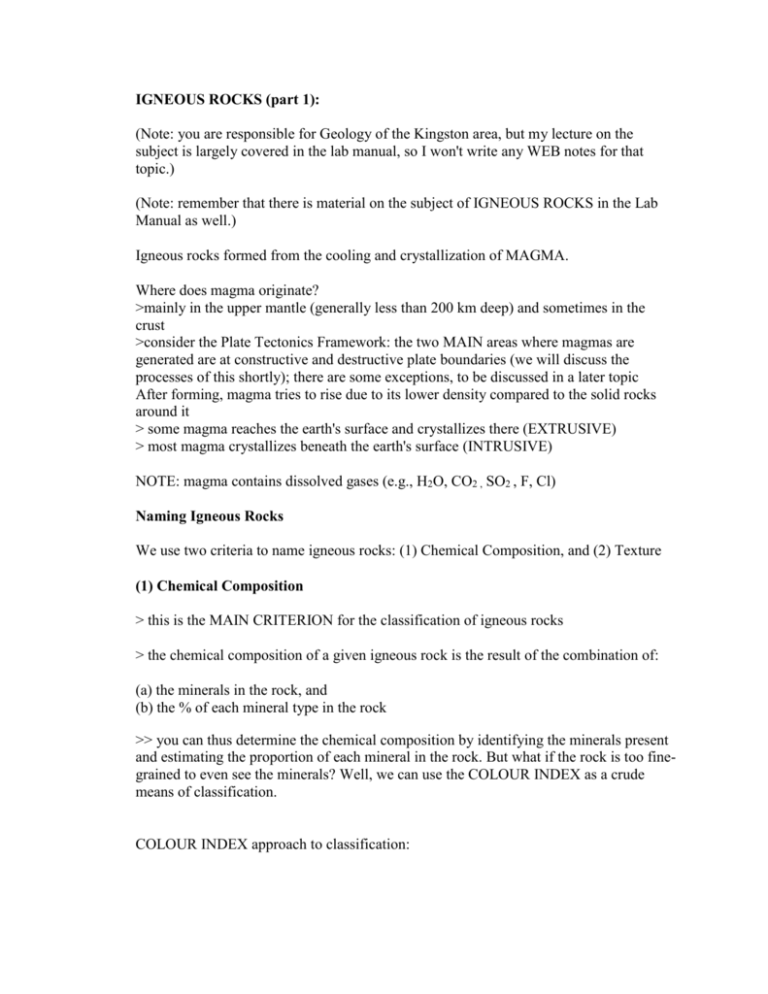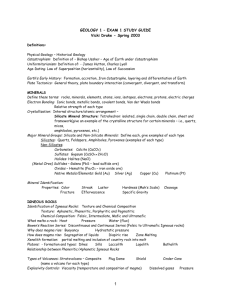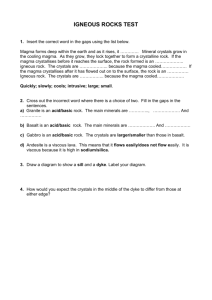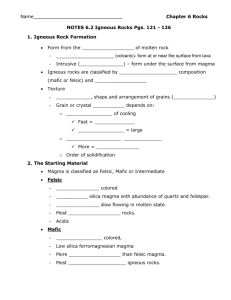07. Igneous Rocks
advertisement

IGNEOUS ROCKS (part 1): (Note: you are responsible for Geology of the Kingston area, but my lecture on the subject is largely covered in the lab manual, so I won't write any WEB notes for that topic.) (Note: remember that there is material on the subject of IGNEOUS ROCKS in the Lab Manual as well.) Igneous rocks formed from the cooling and crystallization of MAGMA. Where does magma originate? >mainly in the upper mantle (generally less than 200 km deep) and sometimes in the crust >consider the Plate Tectonics Framework: the two MAIN areas where magmas are generated are at constructive and destructive plate boundaries (we will discuss the processes of this shortly); there are some exceptions, to be discussed in a later topic After forming, magma tries to rise due to its lower density compared to the solid rocks around it > some magma reaches the earth's surface and crystallizes there (EXTRUSIVE) > most magma crystallizes beneath the earth's surface (INTRUSIVE) NOTE: magma contains dissolved gases (e.g., H2O, CO2 , SO2 , F, Cl) Naming Igneous Rocks We use two criteria to name igneous rocks: (1) Chemical Composition, and (2) Texture (1) Chemical Composition > this is the MAIN CRITERION for the classification of igneous rocks > the chemical composition of a given igneous rock is the result of the combination of: (a) the minerals in the rock, and (b) the % of each mineral type in the rock >> you can thus determine the chemical composition by identifying the minerals present and estimating the proportion of each mineral in the rock. But what if the rock is too finegrained to even see the minerals? Well, we can use the COLOUR INDEX as a crude means of classification. COLOUR INDEX approach to classification: (Note: get out and refer to your igneous-rock classification scheme in your lab manual when reading these sections!) > the higher the proportion of iron- and magnesium-bearing silicates there are in the rock, the darker (i.e., blacker) it will be (since those minerals are generally dark greenish-black or black; e.g., olivine, pyroxene, amphibole, biotite mica). Conversely, the lower the proportion of these ferro-magnesian minerals, the lighter the colour will be (i.e., whiter or pinker) because it is richer in white or pink feldspar and quartz). >> we can thus have a broad classification of igneous rocks into four categories, from FELSIC to INTERMEDIATE to MAFIC to ULTRAMAFIC, where going from FELSIC towards ULTRAMAFIC is going from lighter to darker (Note: FELSIC means rich in feldspar, and MAFIC means rich in Fe- and Mg-bearing minerals) >> so, by its degree of blackness alone, we can decide which of those four categories an igneous rock falls into (Note: in the lab, we only worried about putting a rock into one of the first three categories: Felsic, Intermediate or Mafic). Chemical Analysis Approach to Classification: > we could get a more precise estimate of the chemical composition in order to classify an igneous rock by crushing up the sample, and doing a detailed CHEMICAL ANALYSIS to determine the proportion of the elements present in the rock >> when we do this, we don't talk about the proportion of the elements present, but rather we express the elemental composition by referring to the % of the OXIDES OF THE ELEMENTS e.g., olivine (Mg2 SiO4 ) can be expressed as 2 MgO + 1 SiO2 > when we do this, we find that igneous rocks range from 40% to 75% SiO2 (Reminder!: SiO2 in this context is NOT the amount of quartz, but simply a way of expressing the Si content) >> a FELSIC rock (e.g., granite) has around 65-75% SiO2 >> a MAFIC rock (e.g., gabbro) has around 50% SiO2 (2) Texture: > this is a secondary way of classifying igneous rocks, added on to the main means (chemical composition) of classification > texture refers to the way the minerals in the rock are intergrown >> GRAIN SIZE is the most important textural feature GRAIN SIZE: grain size is controlled by a few factors (rate of cooling, viscosity of magma, and % of volatiles in the magma) (a) Rate of Cooling: this is the most important control on grain size > when magma cools rapidly, there is not time for ions to move around and permit large crystals to grow, so a fine-grained rock forms >> rapid-cooling occurs when magma reaches the cold earth's surface (i.e., the rock is EXTRUSIVE (= volcanic) ) > when magma cools slowly, there is time for ions to move around and for crystals to grow large >> slow cooling occurs when magma cools and crystallizes below earth's surface where the surrounding rocks are relatively hot (i.e., the igneous rock is INTRUSIVE) >> the deeper the igneous rock forms at, the coarser-grained it will generally be >> very deep intrusive rocks are called plutonic, and those at moderate depths (and hence finer grain size than the plutonic ones) are called hypabyssal > so, when we name an igneous rock, we need two different names for a felsic rock: one for the very fine-grained (i.e., phaneritic) extrusive rock (which we call a RHYOLITE) and one for the coarse-grained intrusive rock (which we call a GRANITE) > similarly, an extrusive mafic rock is a BASALT, and an intrusive mafic rock is a GABBRO > if an igneous rock has two distinct sizes of crystals, it indicates that the rock had a twostage cooling history >> the magma must have been fairly deep in the earth for the big crystals to grow, and. while there was still some liquid left mixed with the crystals, the crystal-liquid mush must have risen closer to the earth's surface (perhaps onto the earth's surface) to allow the remaining liquid to crystallize as fine-grained crystals >> we call such a rock a PORPHYRY (you can find porphyries of any igneous rock type, from felsic to ultramafic) (b) Viscosity of Magma: this is a less-important control on texture > remember: viscosity of a magma is a measure of how easily it flows (felsic magmas have high viscosity, which means they don't flow easily (i.e., they are very sticky), whereas mafic magmas have low viscosity and flow very readily) >> the stickiness of the high viscosity felsic magma means the ions can't move around readily, and it is thus harder for the magma to form big crystals. That is why extrusive felsic magmas (i.e., rhyolite in composition) that cool rapidly sometimes don't have time to form any crystals, so a GLASS results. This glassy rock is called OBSIDIAN. >> (Note: although obsidian is a felsic rock and low in Fe content, it is usually dark blackish in colour. This is because the Fe, instead of being concentrated in a few crystals of biotite mica, is uniformly distributed through the glass, and this affects the light passing through to give it a dark colour) (c) % of Volatiles (such as H2O, CO2 ): this also is a less-important control on texture > if a magma is particularly rich in volatiles, these can help to rapidly carry ions around in the magma, transporting them to the sites of crystal growth. This can allow crystals to grow very big, even if the cooling rate is relatively rapid. >> such exceedingly coarse-grained rocks are called PEGMATITES (crystals can be up to metres in length!) >> since the felsic magmas (i.e., granite in composition) are the most water rich, such pegmatites are almost uniformly granite in composition WHY IS THERE A WIDE RANGE IN THE CHEMICAL COMPOSITION OF IGNEOUS ROCKS? > because of a process called MAGMATIC DIFFERENTIATION >> we need to explain what this is and why it happens > magmatic differentiation happens because minerals have different melting temperatures >> for example, at surface pressures, pure quartz, by itself, melts at ca. 1700 degrees Centigrade, pure pyroxene, by itself, melts at ca. 1400 degrees Centigrade, and pureMgrich olivine, by itself, melts at ca. 1850 degrees Centigrade > BUT, minerals in nature most commonly occur mixed with other minerals. So, we need to consider some of the factors in Nature that control the melting temperature of a mineral. There are three such factors we need to consider: the melting temperature of a mineral will depend on: 1. PRESSURE: the higher the pressure (e.g., deeper in the earth), the higher the melting temperature 2. AMOUNT OF WATER PRESENT: addition of water lowers the melting temperature 3. NATURE OF NEIGHBOURING MINERALS (this is a key point for discussion of magmatic differentiation): the melting point of a mineral is affected by what other minerals are around it, and in what proportions. >> for example, at surface pressure, a mixture of 25% quartz and 75% k-feldspar melts at ca. 1150 degrees C, whereas a mixture of 75% quartz and 25% k-feldspar melts at ca. 1400 degrees C A geologist by the name of N.L. BOWEN carried out experimental studies on natural igneous rocks to determine the effects of (3) above >> this resulted in the BOWEN'S REACTION SERIES which shows the order of melting temperatures for the common minerals in rocks >> look at your textbook for a diagram showing the Bowen's Reaction Series (you should be able to reproduce this) for melting points at surface pressure: >> the highest melting points are around 1200 degrees C, and the lowest around 600 degrees C (note: if we include ice, the lowest melting point is 0 degrees C) >> at the low end are K-feldspar, quartz and muscovite mica (600 degrees C) >> there is the Discontinuous Series of the ferromagnesian minerals; for them, olivine has the highest melting point (1200 degrees C), with pyroxene, amphibole and biotite mica at progressively lower temperatures >> the Continuous Series of the plagioclase feldspars has Ca-rich plagioclase at the top (1200 degrees C) and Na-rich plagioclase at the bottom (700-600 degrees C) > compare the Bowen's Reaction Series to your igneous rock Classification Chart and you will see that they are related >> ultramafic rocks are made up of high melting-point minerals (e.g., dunite is 100% olivine); mafic rocks are made up of slightly lower melting-point minerals (e.g., gabbro is 50% pyroxene and 50% Ca-rich plagioclase); felsic rocks are made up of low-melting point minerals (e.g., granite is mostly k-feldspar and/or Na-rich plagioclase feldspar with quartz and a little mica) Now, we can use Bowen's Reaction Series to explain how Nature generates different igneous rocks (i.e, explain how magmatic differentiation occurs): (Note: for magmatic differentiation to happen, there has to be an input of heat (internal heat from the earth) ) > there are two sides to the MAGMATIC DIFFERENTIATION "coin": >> (1) Partial Melting: what can happen when Nature heats up a solid rock >> (2) Fractional Crystallization: what can happen when Nature cools down a magma >> let's look at each side of this "coin" separately (1) Differentiation by Partial Melting > let's start with a solid rock of intermediate composition (e.g., a diorite/granodiorite) and see what will happen as it is gradually heated up by looking at Bowen's Reaction Series (BRS) >> the first liquid to melt of will be rich in elements of those minerals low on BRS (i.e., the liquid is FELSIC in composition) >>***** CRITICAL POINT*****: if this melt is SEPARATED from the remaining solid, then differentiation has happened >> this separation can happen by the low density melt being squeezed out, and having it rise (due to lower density) to another location. It will crystallize in the new place as a granite (or rhyolite if it reaches surface), leaving behind a solid that is more MAFIC than the original rock (it is now a gabbro instead of diorite/granodiorite since a felsic component was removed). > a large-scale example of partial melting occurs at constructive plate margins (e.g., MidOcean Ridges) where new ocean crust is being formed. How does this occur? >> a plastic mass of hot, and therefore low density, ultramafic mantle material rises from deeper in the mantle >> as it approaches the surface at the constructive margin, the lowering of pressure allows partial melting of the hot ultramafic mantle to occur >> the partial melt is more felsic than the ultramafic mantle, but since a large amount melts (20% of the rising mass), it is only somewhat more felsic: in fact, the melt is mafic in composition >> this mafic melt rises up and cools to form the 5 kilometer thick oceanic crust (comprised of basalt and gabbro) > another example of large-scale partial melting occurs at destructive plate boundaries (i.e., convergent boundaries) where oceanic lithosphere dives underneath continental lithosphere >> the frictional heating of the down-going lithosphere with oceanic crust on top (aided by the presence of water, which lowers the melting point) causes partial melting of the mafic ocean crust >> this generates a more felsic magma, which is granodiorite in composition, which rises into the continental crust >> we believe this is how the continental crust grew bigger in the early history of the earth (and may still be growing today) (2) Differentiation by Fractional Crystallization > this is the opposite side of the "coin" from partial melting >> start with a magma and cool it down and see what happens >> let's start with a magma chamber of intermediate composition (i.e., diorite/granodiorite) that is well above 1300 degrees C > as the magma cools and the temperature drops, minerals will crystallize in order down the Bowen's Reaction Series (i.e., a fraction of the magma crystallizes) >> but to get differentiation, early-formed minerals must be SEPARATED from the remaining magma >>> this could happen by the liquid being squeezed off with the early-formed crystals being left behind. The left-behind crystals would form an ultramafic rock, and the squeezed-off liquid would be granitic >>> another way that separation could occur is if the early crystals settle out of the magma. They have a tendency to do this because the crystals are more dense than the remaining magma. >>>> consider a :dioritic" magma experiencing crystal settling. At 1200 degrees C, the first crystals of olivine could settle to make an ultramafic layer at the bottom of the magma chamber. The remaining magma is now more felsic. As the temperature reaches 1100 degrees C, pyroxene and Ca-rich plagioclase crystallize and settle out to form a layer of mafic composition (i.e., a gabbro). At 1000-900 degrees C, crystals of amphibole and Na-rich plagioclase form and settle out to form a layer of granodiorite. And finally, the remaining liquid cools and crystallizes to form a granite layer on top. Hence, this process can produce a LAYERED INTRUSION, which is ultramafic on the bottom, grading up through mafic, intermediate, to felsic (granite) on the top. (NOTE: In a cooling magma chamber, differentiation might not occur if there is constant convective mixing. This mixing keeps the crystals from settling. What happens then is that the early-formed crystals will REACT (hence the term Bowen's Reaction Series) with the remaining liquid. This can transform olivine into pyroxene, and so on down the Discontinuous arm of the BRS, and Ca-plagioclase into more Na-rich plagioclase down the Continuous arm of the BRS, as the temperature drops. Ultimately, if there is constant mixing, the final rock-body is the same composition as the starting magma, and no differentiation has occurred.) ORE DEPOSITS RELATED TO MAGMATIC DIFFERENTIATION PROCESSES (1) Deposits of Chromite (FeCr2 O4 ) > these chromite deposits occur as thin (ca. 1 metre thick or less) layers of chromite associated with the ultramafic part of some large layered intrusions (e.g., the Bushveld intrusion in South Africa) >> how do these form? > the melting point of chromite is high (1300 degrees C) >> at high temperatures in the magma, chromite can crystallize early, along with olivine >> these dense minerals can then settle to form the chromite-rich layers in the ultramafic part of the layered intrusion (Note: to form thick enough chromite layers to be mined, the magma chamber must be very large) (2) Deposits of Ni-Cu Sulphides > these deposits occur as Ni-Cu sulphide layers in the ultramafic and mafic parts of some layered intrusions (e.g., in Sudbury, Ontario) >> how do they form? > during the fractional crystallization of a magma chamber, up at ca. 1200 degrees C, liquid drops of Ni-Cu sulfides can form and, due to their high density, sink to the bottom of the magma chamber (this is a process of liquid immiscibility: the silica magma and the Ni-Cu sulfide magma don't mix at those temperatures) >> these droplets sink at the same temperature that the pyroxene + Ca-rich plagioclase sink to make mafic layers (3) Deposits of Cu-Mo-Ag-Au-Sn > these are metal sulfides and native metal in veins in granite to granodiorite (i.e., "felsic") porphyry intrusions >> during the crystallization of the felsic to intermediate magma at depth, some felsic magma rises up to higher levels beneath a volcano >> as the magma crystallizes, the very last liquid part is highly enriched in water (called a hydrothermal solution) with dissolved "incompatible" metals (such as Mo, Ag, Au, Sn, etc.) (the water is enriched because of the low melting point of ice: think of BRS) >> as the granite porphyry cools, hardens and shrinks, cracks form (veins) that the hot water solutions can move along. As the water cools, it dumps the metals as sulfides and native metal Last revision: 25 October 2000 These pages and their contents are Copyright © of the Department of Geological Sciences, Queen's University 20002001 (except as noted). If you have any problems with this web service, Email badham@geol.queensu.ca Back to APSC151 Course Notes Page









